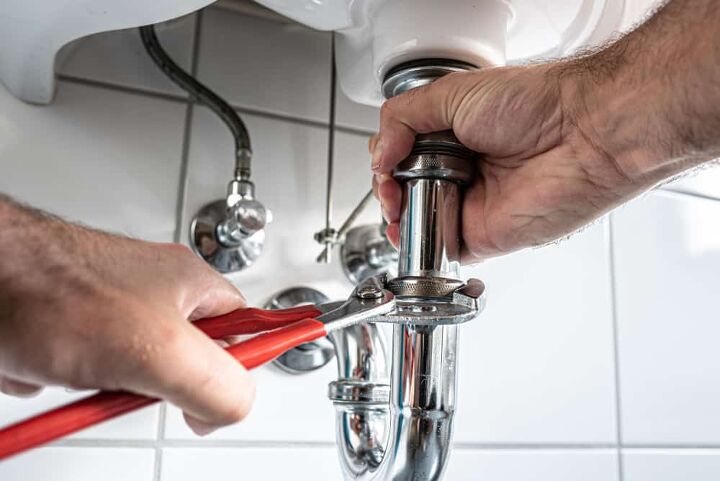15 Different Types of Traps In Plumbing

Plumbing traps can confuse any builder-owner that is trying to figure out the best fit for their home. There are many types of plumbing traps that are often similar and hard to differentiate between. With that said, what are the main types of traps in plumbing?
P-traps, S-traps, straight-through traps, and bell traps are among the most common types of traps in plumbing. Options like bottle traps, drum traps, and gully traps also effectively retain water to prevent sewer odors from coming out. Building traps and intercepting traps are the best types of traps for large buildings and businesses.
It is important to vent any plumbing fixture with a trap to enforce a strong water seal. Otherwise, you will violate U.S. building codes and will fail any future plumbing inspection. Follow along as we take an in-depth look at all of the different types of traps in plumbing.
Types of Plumbing Traps
1. P-Trap
You can find P-traps underneath your toilet or sink, and their “U” shape is easy to spot. They are optimal because of their shape and design that keeps foul odors at bay and out of the house. P-traps connect to the drain and are installed through the wall instead of the floor, like with S-traps.
Modern homes often have P-traps because of their simple design and how effective they are. They require little to no maintenance, and they don’t use much water at all because of their design. You most likely have a P-trap if you recently built your home, or you bought a newer house.
Plumbers recommend P-traps because of their design, function, and reliability that you can count on. You won’t have to water about water getting stuck in the trap, foul odors escaping the pipes, or having it maintained often. It’s easy to connect a P-trap to a wall drain, and any DIY-minded homeowner can do it on their own.
2. S-Trap
S-traps are plumbing traps with a distinct “S” shape, and they are quite large. They are hard to miss because of their shape and size when compared to P-traps or U-traps. S-trap outlets are installed through the floor instead of the wall, and they are known for letting out bad smells.
The main difference between a P-trap and an S-trap is that S-traps are bigger and waste more water. They also entail more maintenance than P-traps, and that makes S-traps less popular than similar plumbing traps. S-traps are not even up to code anymore, so only older homes that haven’t been updated contain S-traps.
Replace your S-trap if you have an older home with outdated plumbing traps as they are not effective.
3. Bottle Trap
The bottle trap is perfect for small spaces under sinks that are cramped because of its shape. They go straight up and down horizontally which maximizes space and makes it easy to maintain. You can service and clean a bottle trap from the bottom which simplifies the cleaning process.
Bottle traps are effective at trapping and minimize odors from your sink, and that is their main appeal. They are ideal for deep washbasins with limited space below, but they are great for any sink because of how sanitary they are. You can expect to spend between $20 and $150 on a bottle trap, and prices vary by materials, such as brass.
It is easy to install bottle traps because of their simple horizontal design. They are also durable, and brass bottle trap fittings can last as long as 70 years if it stays in shape.
4. Drum Trap
Drum traps are a plumber’s dream because they make it easy to access the line and remove blockages as needed. There is a hole at the bottom of the drum trap, and another at the top that allows for water to flow through it. Water enters through the bottom and goes into the center drum shape in the middle of the trap.
From there, any potential blockage is held as the water is passed through the hole at the top of the trap. This system is effective for productive water flow, and it’s even better for protecting your plumbing system. The drum trap function helps minimize the risk of blockages and clogs which can save you time and even money.
You can access the drum trap easily from the top so that you can get rid of obstructions before they cause a problem. Sewer gases are no problem with drum traps because water is always present in the trap.
5. Bell Trap
You can use bell traps if you have outdoor plumbing appliances on your patio, or in an outhouse. They are also used for sinks and bathrooms in garages, and bell traps are extremely effective at suppressing sewer odors. Bell traps are easy to install and go directly on top of drain bodies to trap water in the well to keep gases inside of it.
With that said, bell traps have fallen out of favor for homeowners that prefer more sanitary options like P-traps. Bell traps can clog more easily than options like bottle and drum traps as well, and that’s their main downside. They function well, but bell traps are only useful if you have an outdoor plumbing application.
6. Q-Trap
Use a Q-trap if your home with multiple floors that have bathrooms as they’re ideal for upper-level usage. They function almost exactly like P-traps and S-traps, and the main difference is the distinct “Q” shape. Besides that, Q-traps are your basic plumbing trap intended to ward off sewer odors using water and piping.
The Q-trap traps water in the “U” shaped part of its body exactly as it does with a P-trap, and they are effective. Choosing between a Q-trap and a P-trap is mostly up to personal choice, or how much space you have below the drain. Run the water regularly and you will never worry about your Q-trap drying out.
7. Shallow Trap
Shallow traps come in handy if you have limited space under your tub or shower. Not all bathrooms have enough space over the floor to adequately install other plumbing traps, and that’s when shallow traps are ideal. They are great for controlling bath overflow, and they require a simple banjo connector when you install them.
You can also add extra inlets for your shallow trap if you have a problem with water overflow from the bath. However, that is not necessary for all homeowners, but an extra inlet removes the need for a banjo connector. Make sure that your shallow trap is up to your local or neighborhood water regulation standards and meets depth requirements.
8. Intercepting Trap
Homeowners don’t need to use intercepting traps, but they are common among large buildings and intercept at the sewer systems. They are effective and can handle large quantities of wastewater from multiple plumbing applications in a large building. Most office buildings and big businesses have to intercept traps to accommodate their plumbing needs without letting sewer odors escape.
Intercepting traps ward off bugs and other pests because of how deep and strong they are. There is a 100 mm water seal depth requirement for intercepting traps that explain how effective they are. You can’t trust simple P-traps, bottle traps, and drum traps to handle an entire building’s water usage, and that’s where intercepting traps come in handy.
Intercepting traps are more elaborate than standard plumbing traps because of how much responsibility they have. You can find intercepting traps in big buildings in the last main hole where it meets the sewer system.
9. Gully Trap
Gully traps connect to sewer lines outside of the building or house to collect and trap water from kitchen plumbing fixtures. Guidelines require that gully traps weigh at least 16 pounds so that it is sturdy enough to handle the pressure surrounding it. You can bury your gully trap no less than 1 foot beneath the ground, if not deeper, to ensure a proper connection and installation.
Water seal integrity is critical when it comes to gully traps just as much as an intercepting trap. The water seal must be at least 50 millimeters so that you don’t have to worry about it wearing out. Pests and bugs can get into traps, so the water seal is of the utmost importance when it comes to gully traps.
Install your gully trap properly and you won’t have to worry about damaging your water seal or letting pests in your plumbing line.
10. Running Trap
It’s uncommon to see running traps in a home, but they are quite common in public restrooms. Running traps serve public restrooms that have many washbasins in a row, but they are occasionally used in the home. You only need to use a running trap in a home if you can’t make it work with P-trap, S-trap, or Q-trap.
Some homeowners forego traps meant for dishwashers and laundry machines and use a running trap instead. Running traps are good substitutes for laundry and dishwasher traps, especially if you have one on hand. They don’t connect to the plumbing fixture directly, but running traps still prevent sewer odors from seeping out of the drain.
11. Building Trap
Building traps run from a building’s drain to the sewer with a U-shaped trap in the center and a vent leading outside on the end. You need to vent a building trap to make it more sanitary and protect the water seal. Building traps vary in shape, but they are generally a bulkier, more durable version of an S-trap to accommodate for the higher demand.
They are just as good at keeping unwanted bugs and pests out of the house or building as they are repelling odors. Building traps exist to mitigate the chance of dangerous siphonage that could lead to harmful gases escaping the drain. You will violate U.S. building codes if you fail to vent a building trap.
12. Straight Through Trap
A straight-through trap is a simple, yet less effective form of a plumbing trap used in many homes. The main disadvantage to straight-through traps is that water moves slowly through the trap. This makes straight-through traps work less effectively than a P-trap or S-trap.
With that said, straight-through traps are still quite useful for spaces that are tight and cramped due to their simple shape. Homeowners generally install a straight-through trap in a small full bathroom with a tight wash basin or sink. Straight-through traps are often slow, but some new models feature a valve that can affect the seal and speed.
13. Grease Traps
Grease traps are the last line of defense between a kitchen and the wastewater system. They work to keep thick grease and solid bits from getting into and harming the wastewater system in a kitchen. All restaurants and fast food establishments use grease traps, and if they didn’t, they wouldn’t be in business for too long.
Grease and solid waste that comes up while preparing food are quite dense and unable to make their way through a grease trap. This prevents harmful clogs or leaks of grease that could lead to expensive repairs or replacements. Instead, a grease trap holds on to the thick grease at the top of the trap so that it never becomes a problem.
14. Floor Drain Trap
Floor drain traps are a must for most homeowners, and they’re quite effective. They trap water that comes from sinks and showers in bathrooms, and they successfully suppress sewer gases. You need a water seal that measures between 55 and 110 millimeters to prevent damage and sewer odors from coming up.
Sometimes, floor drain traps can become dry, and that will lead to foul odors filling the air in your house. Pour water down the drain or run your plumbing fixtures regularly if that is a problem for you. You can expect your floor drain trap to last you at least 20 years if it is made of PVC and you keep it from running dry.
15. Low-Level Bath Trap
Low-level bath traps provide overflow access which is useful if you have a clog. They are easy to vent, and low-level bath trap seals typically measure 38-40 millimeters. Low-level bath traps may seem small, but their seals are powerful enough to prevent sewer odors from coming through.
They are a great option for below a bathtub or shower because low-level bath traps are slim enough to fit in small spaces. You may not be able to connect a low-level bath trap to all vent stacks, but they are worth the trouble.
Why are Plumbing Traps Required to be Vented?
You must vent a plumbing trap to comply with national building codes and for your safety. An unvented trap can easily overflow or go dry because it may lose the water seal. The water seal can keep sewer gases out of your house that could otherwise escape from the drain.
A poorly-vented plumbing trap is just as bad as no vent at all, and it can cause drainage problems. Slow drainage can occur if you fail to vent a fixture with a plumbing trap. Listen for unusual gurgling signs and watch for bubbles in your toilet that can indicate your plumbing trap isn’t properly vented.
Related Questions
Why do you need a trap in plumbing?
You need a plumbing trap so that sewer odors and gases don’t climb up the pipes and emit from the drain. Plumbing traps that dry out when you don’t run enough water also run the risk of letting sewer odors escape the drain. Keep your plumbing trap wet by running the water often so that the trapped water can keep the odors out of your house.
How long does a sink trap last?
Sink traps can cost between 20 and 80 or more years based on the material that you choose. Materials such as PVC generally last a minimum of 20 years before you need to replace them. Materials such as brass and copper are likely to last 70-80 years if you maintain them well.
Summing It Up
The most common types of plumbing traps are S-traps, P-traps, and Q-traps, but there are many more. Bottle traps, bell traps, and drum traps are also great plumbing traps, especially if you are trying to make the most of your space. You can’t be sure that every type of plumbing trap is allowed under your local building codes, so you must check.
Building traps and intercepting traps are examples of plumbing traps that are more common in business office buildings than homes. Even still, even building traps are used in homes, and they are well-vented to protect residents from harmful odors. Gully traps are one of the sturdiest types of traps in plumbing, and they are buried beneath the ground.
Each of these types of plumbing traps has different applications, and not all of them may meet your building standards. If you have enough space, all that you may need is an S-trap or P-trap, but specialty variations like bottle traps may come in handy.
Related Guides

Nick Durante is a professional writer with a primary focus on home improvement. When he is not writing about home improvement or taking on projects around the house, he likes to read and create art. He is always looking towards the newest trends in home improvement.
More by Nick Durante










































